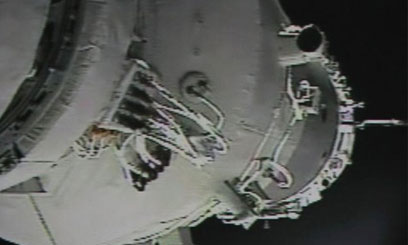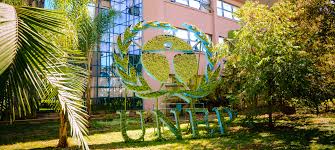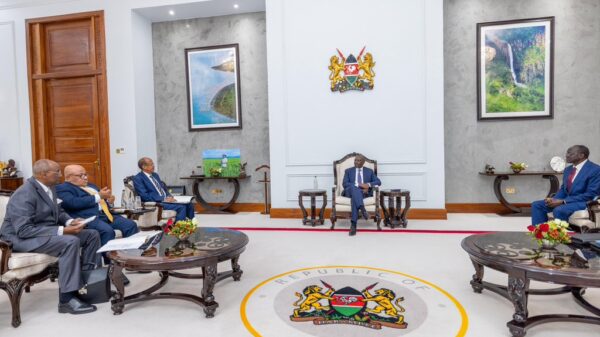
A photo of the giant screen at the Jiuquan space center shows the Shenzhou-9 spacecraft undergoing the automatic docking © AFP
The manual “kiss in space” is the main goal of China’s current manned mission, which began over a week ago when the Shenzhou-9 spacecraft lifted off carrying three crew members, including the nation’s first female astronaut.
The manual docking is scheduled to take place around noon (0400GMT) Sunday, state media said.
On June 18, the spacecraft came together in an automatic docking with the Tiangong-1 module in orbit around Earth, which the three astronauts entered several hours later — a first for China — and have been living in since.
In preparation for the manual docking the Shenzhou-9 separated from the space module shortly after 11:00 am (0300GMT), state television said, after all the astronauts returned to the cabin of the spacecraft.
The Tiangong-1 is an experimental module that will only stay in orbit until 2013 and will later be replaced, but is designed to test the docking technique essential to building a space station — which China aims to do by 2020.
The manual docking technique is hard to master as it involves two vessels — placed in the same orbit and revolving around Earth at thousands of kilometres (miles) per hour — coming together very gently to avoid destroying each other.
“Compared with the automatic docking, the upcoming manual docking will be more challenging in terms of orbit control,” Xie Jianfeng, a scientist at the Beijing Aerospace Control Centre, was quoted by Xinhua as saying in a report late Saturday.
He added the operation must be prepared for “changes in the space environment”.
China has already completed several automatic dockings but the ability to dock manually is necessary in case of problems with the automatic procedure, such as the control centre being unable to carry it out remotely from Earth.
The manoeuvre — which was successfully completed by the Americans and Russians in the 1960s — requires great accuracy and dexterity from astronauts.
The team — headed by Jing Haipeng, a veteran astronaut on his third space mission — have rehearsed the procedure more than 1,500 times in simulations.
Liu Wang, who has been in the space programme for 14 years, will be in charge of manual docking manoeuvres, while Liu Yang, China’s first woman to travel to space, will conduct aerospace experiments while in orbit.
The current manned mission — China’s fourth — has been closely followed in state-run media, with much of the attention focused on Liu Yang, who at 33 is the youngest of the three.
She has been hailed as a national heroine and her mission is being excitedly followed in the Chinese media and on the country’s popular microblogs.
Xinhua said all three astronauts were in “good condition” after over a week in space, following the launch on June 16. State media has said the mission is scheduled to last 13 days.
China sees its space programme as a symbol of its global stature, growing technical expertise, and the Communist Party’s success in turning around the fortunes of the once poverty-stricken nation.

































